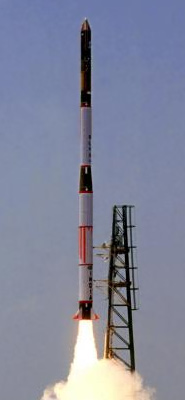Top Qs
Timeline
Chat
Perspective
Satellite Launch Vehicle
First launch vehicle of the Indian Space Research Organisation From Wikipedia, the free encyclopedia
Remove ads
The Satellite Launch Vehicle or SLV was a small-lift launch vehicle project started in the early 1970s by ISRO to develop the technology needed to launch satellites. SLV was intended to reach a height of 400 kilometres (250 mi) and carry a payload of 40 kg (88 lb).[2] The first experimental flight of SLV, in August 1979, was a failure.[3] The first successful launch took place on 18 July 1980.
It was a four-stage rocket with all solid-propellant motors.[3]
The first launch of the SLV took place in Sriharikota on 10 August 1979. The fourth and final launch of the SLV took place on 17 April 1983.
It took approximately seven years to realise the vehicle from start. The solid motor case for first and second stage were fabricated from 15 CDV6 steel sheets and third and fourth stages from fibre reinforced plastic.[1] The aerodynamic characterization research was conducted at the National Aerospace Laboratories' 1.2m Trisonic Wind Tunnel Facility.[4]
Remove ads
Launch history
Summarize
Perspective
All four SLV launches occurred from the SLV Launch Pad at the Sriharikota High Altitude Range. The first two launches were experimental (E) and the next 2 were designated as developmental (D) as this was the first launch vehicle being developed by India not intended for a long service life.[5]
Remove ads
Launch statistics
1
1979
1980
1981
1982
1983
- Failure
- Partial failure
- Success
- Decade-wise summary of SLV launches
See also
References
External links
Wikiwand - on
Seamless Wikipedia browsing. On steroids.
Remove ads

